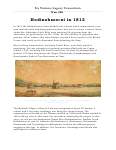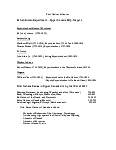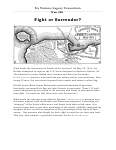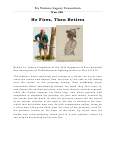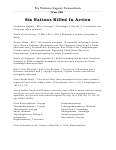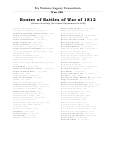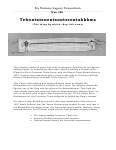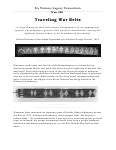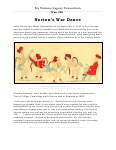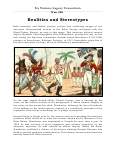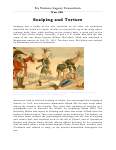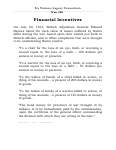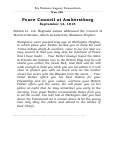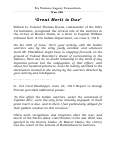Results
- This design is of the Haudenosaunee 1812 Peace Monument. Each of the clans and each of the six nations encircle the monument which is scheduled to be erected at the Six Nations Veterans Park in JulyThis design is of the Haudenosaunee 1812 Peace Monument. Each of the …
- Seventeenth in a 62 part series, Hodinohsonni in 1812 is a historical summary describing the state of Haudenosaunee (Iroquois Confederacy) community as it existed in 1812.Seventeenth in a 62 part series, Hodinohsonni in 1812 is a historical …
- A historical timeline of the War of 1812. List compiled by the Six Nations Legacy Consortium.A historical timeline of the War of 1812. List compiled by the …
- A bibliography of resources pertaining to the War of 1812.A bibliography of resources pertaining to the War of 1812.
- An analysis of the War of 1812 from the perspective of Six Nations communities.An analysis of the War of 1812 from the perspective of Six …
- Six Nations Warriors who served during the Patriot Rebellion. Researched and compiled by the Six Nations Legacy Consortium.Six Nations Warriors who served during the Patriot Rebellion. Researched and compiled …
- This document gives a list of numbers of Native allied forces who participated in the War of 1812, and which battlesThis document gives a list of numbers of Native allied forces who …
- Eighth in a 62 part series, Fight or Surrender describes the remarkable military victory of thirty-six Haudenosaunee (Iroquois Confederacy) warriors, winning in battle against a much larger AmericanEighth in a 62 part series, Fight or Surrender describes the remarkable …
- Twenty-Sixth in a 62 part series, He Fires, Then Retires is a description by British Lt. James FitzGibbon of the Haudenosaunee (Iroquois Confederacy) warriors fighting tactics in the War of 1812.Twenty-Sixth in a 62 part series, He Fires, Then Retires is a …
- Thirty-Third in a 62 part series, Pledge of the Crown Wampum Belt describes a wampum belt created by the British to represent the ongoing relationship with the Native community after the warThirty-Third in a 62 part series, Pledge of the Crown Wampum Belt …
- Fourteenth in a 62 part series, Six Nations Killed In Action is a list of Native Chiefs and Warriors who were killed in action during the War of 1812. This list was compiled using available informatiFourteenth in a 62 part series, Six Nations Killed In Action is …
- Fifteenth in a 62 part series, Roster of Battles of War of 1812 is a chronological list of the battles that occurred during the War of 1812.Fifteenth in a 62 part series, Roster of Battles of War of …
- Sixteenth in a 62 part series, Tehontatenentsonterontahkhwa describes the Wampum Friendship Belt, and its historical use by Haudenosaunee (Iroquois Confederacy) as a tool of diplomacy.Sixteenth in a 62 part series, Tehontatenentsonterontahkhwa describes the Wampum Friendship Belt, …
- Eighteenth in a 62 part series, Traveling War Belts describes the visual symbolism depicted in the designs of Wampum Belts, and outlines their relationship to Native spiritual ideasEighteenth in a 62 part series, Traveling War Belts describes the visual …
- Nineteenth in a 62 part series, Norton’s War Dance describes John Norton’s participation in a traditional native war dance.Nineteenth in a 62 part series, Norton’s War Dance describes John Norton’s …
- Twentieth in a 62 part series, Realities and Stereotypes describes the negative racial stereotypes of natives which existed in American and British political cartoon of the early 19th centuryTwentieth in a 62 part series, Realities and Stereotypes describes the negative …
- Twenty-First in a 62 part series, Scalping and Torture describes the use of scalp mutilation in the War of 1812. Employed primarily as a tool of intimidation and psychological warfare by all sides inTwenty-First in a 62 part series, Scalping and Torture describes the use …
- Twenty-Second in a 62 part series, Financial Incentives describes the system British officials had instituted to financially reimburse native warriors and the widows of deceased warriors for losses tTwenty-Second in a 62 part series, Financial Incentives describes the system British …
- Twenty-Third in a 62 part series, Peace Council at Amherstburg excerpts the speech given by British Lt. Col. Reginald James in front of the Council of Western Nations on September 14, 1815. The speecTwenty-Third in a 62 part series, Peace Council at Amherstburg excerpts the …
- Twenty-Fourth in a 62 part series, Great Merit is Due Excerpts quotes from letters by British military leaders acknowledging the enormous role Native Warriors had in ensuring a victory over AmericanTwenty-Fourth in a 62 part series, Great Merit is Due Excerpts quotes …
When selecting an individual record or object, you will move
to the website of the heritage institution that houses the item.
To return to the search or results pages, select "Back", "Results" or "New Search".
 This project was made possible with the support of the Department of Canadian Heritage
This project was made possible with the support of the Department of Canadian Heritage
through the Canadian Culture Online Strategy.
to the website of the heritage institution that houses the item.
To return to the search or results pages, select "Back", "Results" or "New Search".
 This project was made possible with the support of the Department of Canadian Heritage
This project was made possible with the support of the Department of Canadian Heritage through the Canadian Culture Online Strategy.








